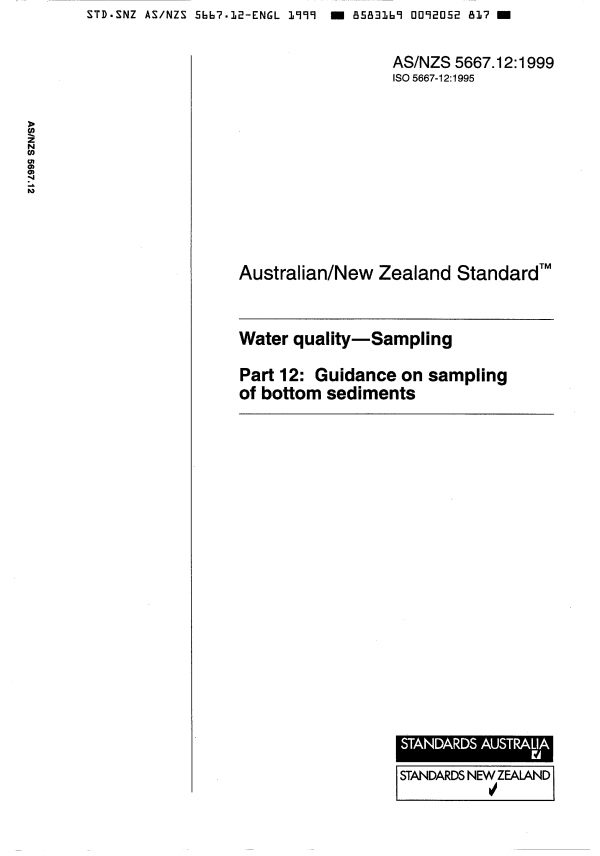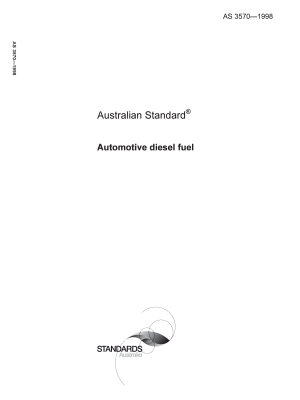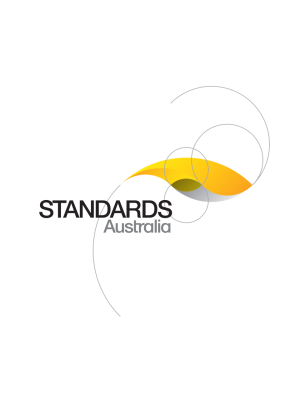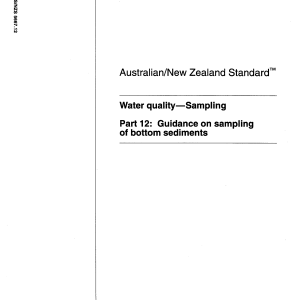🔍

Purchase the full subscription package now and enjoy a 40% discount, along with free updates for future editions.
AS/NZS 5667.12:1999
$149.01
Water quality — Sampling, Part 12: Guidance on sampling of bottom sediments
Provides guidance on the sampling of sedimentary materials from inland rivers and streams; lakes and similar standing bodies of water; and estuarine and harbour areas. Open ocean sediments and sludges from industrial and sewage works are specifically excluded. This Standard is identical with and has been reproduced from ISO 5667-12:1995.
Table of contents
Header
About this publication
Preface
1 Scope
2 Normative references
3 Definitions
4 Sampling equipment
4.1 Sampling container materials and types
4.2 Criteria for selection of apparatus
4.2.1 Type of investigation
4.2.1.1 Chemical investigation
4.2.1.2 Physical investigation
4.2.1.3 Biological investigation
4.3 Types of apparatus
4.3.1 Grab systems
4.3.1.1 General
4.3.1.2 Scissor grab or clam-shell buckets
4.3.1.2.1 Application
4.3.1.2.2 Type of bed
4.3.1.2.3 Accuracy of sample
4.3.1.2.4 Nautical conditions
4.3.2 Corer systems
4.3.2.1 Application
4.3.2.2 Type of bed
4.3.2.3 Accuracy of sample
4.3.2.4 Nautical conditions
4.3.2.5 Other information
4.3.2.6 Manually operated sampling apparatus
4.3.2.6.1 Piston drill
4.3.2.6.2 Corer system involving a diver
4.3.2.6.3 Beeker core sampler (see annex D)
4.3.2.6.4 Sealed core sampler (see annex E)
4.3.2.6.5 Vrijwit drill or wedge corer(see annex F)
4.3.3 Mechanically operated sampling apparatus
4.3.3.1 Falling bomb core sampler (see annex G)
4.3.3.2 Jenkins mud sampler core sampler(see annex H)
4.3.3.3 Craib corer sampler (see annex J)
4.3.3.4 Easy All core sampler
4.3.3.5 Vibro corer sampler
4.3.3.6 Piston corer sampler (see annex K)
4.3.3.7 Peat borer
4.3.3.8 Cold finger techniques
5 Sampling procedure
5.1 Choice of sampling site
5.2 Choice of sampling point
5.3 Choice of sampling method
5.4 Frequency and time of sampling
5.5 Site conditions
5.5.1 Climatological conditions
5.5.2 Hydrographical conditions
5.5.2.1 Tidal areas
5.5.2.2 Rivers
5.5.2.3 Standing bodies
5.5.3 Sediment conditions
5.5.4 Nautical conditions
5.5.5 Weed congestion
6 Composite samples
7 Storage, transport and stabilization of samples
8 Safety
9 Statistical considerations of sampling
10 Sample identification and records
Annex A
A.1 Apparatus (see figure A.1)
A.2 Types in use
A.3 Method of operation
A.4 Screen top sediment sampler
Annex B
B.1 Apparatus (see figure B.1)
B.2 Nature of the sample
B.3 Location conditions
B.4 Nautical conditions
B.5 Method of operation
Annex C
C.1 Apparatus
C.1.1
C.1.2
C.1.3
C.1.4
C.1.5
C.2 Nautical conditions
C.3 Method of operation
Annex D
D.1 Apparatus (see figure D.1)
D.2 Application
D.3 Type of bed
D.4 Accuracy of sample
D.5 Nautical conditions
D.6 Sediment
D. 7 Methods of operation
D.7.1 Use of the Beeker sampler with extension rods
D.7.2 Use of the Beeker sampler in a frame
Annex E
E.1 Apparatus (see figure E.1)
E.2 Method of operation
Annex F
F.1 Apparatus (see figure F.1)(see figure F.1)
F.2 Method of operation
Annex G
G.1 Apparatus (see figureG.1)
G.2 Application
G.3 Type of sediment bed
G.4 Accuracy of sampling
G.5 Operation
G.6 Nautical conditions
G.7 Method of operation
Annex H
H.1 Apparatus (see figure H.1)
H.2 Operation
H.3 Nautical conditions
H.4 Method of operation
Annex J
J.I Apparatus (see figure J.1)
J.2 Application
J.3 Nautical conditions
J.4 Sediment bed conditions
J.5 Method of operation
Annex K
K.I Apparatus (see figure K.1)
K.2 Types in use
K.3 Application
K.4 Type of sediment bed
K.5 Accuracy of sample
K.6 Operation
K.7 Nautical conditions
K.8 Method of operation
Annex L
L.1 Description of the Peat Institute peat drill model 1
L.2 Peat Institute drill (year 1939 model)
L.3 Sounding-rod drill
Annex M
Cited references in this standard
Please select a variation to view its description.
| Published | 05/03/1999 |
|---|---|
| Pages | 34 |
Please select a variation to view its pdf.



